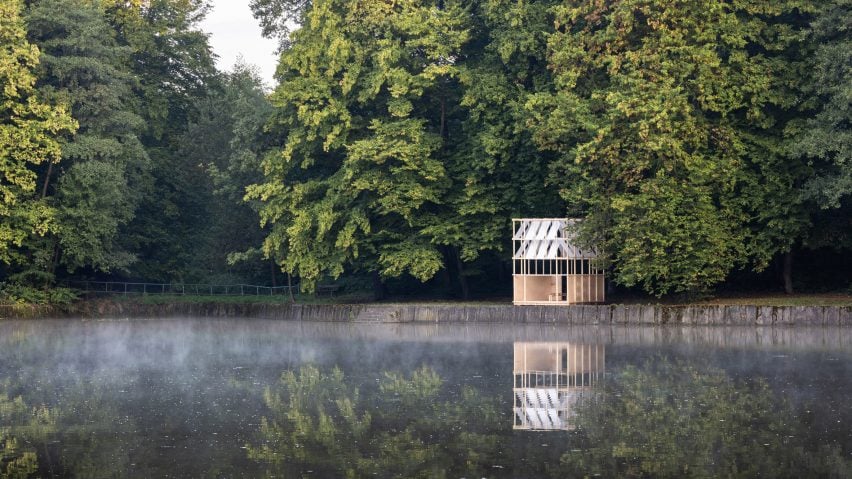Slovakian studio Grau Architects has used spruce, plywood and white fabric to build the lantern-like Tea House Pavilion, which offers a place to rest for visitors of Hrabinka Lake in the Czech Republic.
The building, which is located next to the lake near the town of Český Těšín, was designed as a contemporary take on traditional Japanese architecture.
It has a low table at its centre that can be used for tea ceremonies or for quiet contemplation.
The pavilion is made from locally sourced spruce wood, helping to blend the structure into the treeline behind it while working within the project's practical and budgetary restrictions.
"We decided to use a subtle spruce profile from a local source, aligning the design, our own requirements, budget and the current market offer, which was also significantly limited after the Covid-19 pandemic," Grau Architects told Dezeen. "Wood ages naturally and we naturally accept it."
Plywood clads the lower part of the nine-square-metre building, while thin white fabric protects its upper half and creates a decorative gauzy roof.
Though the pavilion's design was informed by traditional tea houses and can be used for tea ceremonies, its main function is to offer a resting place next to Hrabinka Lake – located in the eastern Czech Republic near the Polish border.
"The pavilion was designed for unknown visitors but at the same time for anybody who would like to take time by the river and contemplate for a while," the studio said.
To enter the four-metre-high pavilion, visitors have to bend down to pass under a low horizontal beam in a nod to Japanese niriji-guchi doors, which symbolise the equality of all participants in tea ceremonies.
The pavilion has a square floor plan measuring three by three metres, providing enough space for six people to comfortably sit around the low table. At night time, the building is lit up to create a lantern-like feel.
"The subtle and light open construction refers to traditional Japanese interiors but brings modern elements into it," the studio explained.
The pavilion was designed as part of the 2022 Mood for Wood international design workshop for students and young designers.
Other recent Czech projects include a gabled wooden headquarters for a timber company and a trio of mirror-clad installations.
The photo is by Matej Hakár.
Project credits:
Architects: Grau Architects – Andrej Olah, Filip Marčák, Jana Filípková and Alexandra Májska
Client: Mood for Wood
Co-creators (students, workshop participants): Julia Kurnik, Alicja Łosik, Alexandra Gospodarek, Katarzyna Owczarska, Maria Pawłova, Maciej Kuratczyk, Michał Teodorczyk, Jan Chmurski

